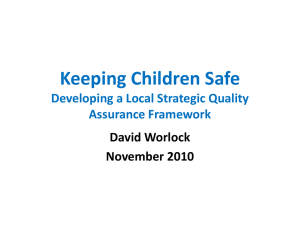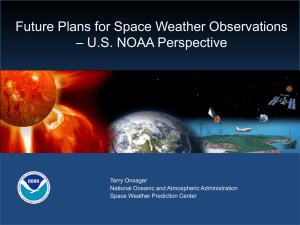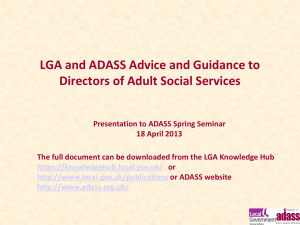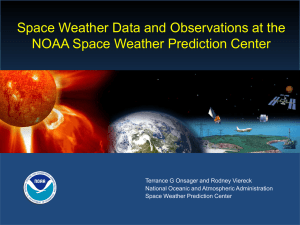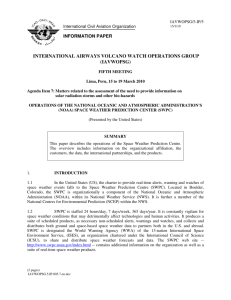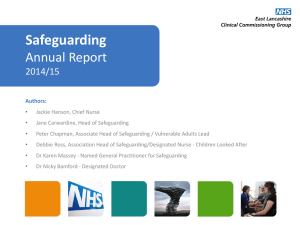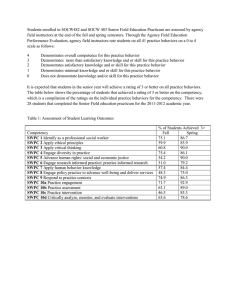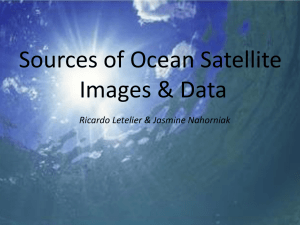Tom Bogdan
advertisement
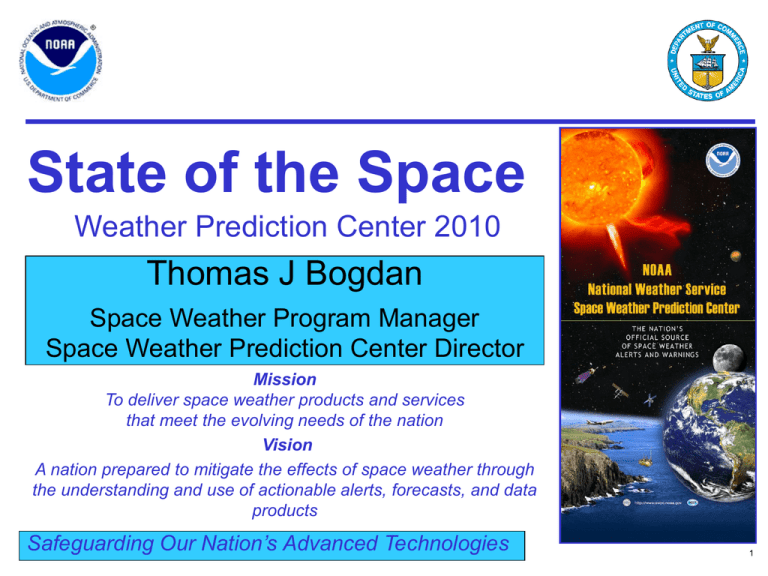
State of the Space Weather Prediction Center 2010 Thomas J Bogdan Space Weather Program Manager Space Weather Prediction Center Director Mission To deliver space weather products and services that meet the evolving needs of the nation Vision A nation prepared to mitigate the effects of space weather through the understanding and use of actionable alerts, forecasts, and data products Safeguarding Our Nation’s Advanced Technologies 1 Outline/Headlines • • • • • • • • Solar Activity is Back Customers Continue To Multiply SWPC Base Budget is Going Up ACE and COSMIC Follow-ons are in NOAA’s FY11 Budget Request WSA-Enlil in Production Mode at NCEP GOES 14/15 Launched; XRS Gap Avoided ACE RTSW Network Secured Over European Sector Legacy DEC and HP Computers Retired Safeguarding Our Nation’s Advanced Technologies 2 New Solar Cycle! (…Is Finally Here) Safeguarding Our Nation’s Advanced Technologies 3 SWPC Today Mission To provide space weather products and services that meet the evolving needs of the nation Office of the Director Tom Bogdan Execute Project Management Team Strategic Direction Team Plan Coordinate Administer Manage Collaborate Lead Space Weather Services Branch Brent Gordon Customer Focus Section Product Services Section Forecast Office Doug Biesecker Steve Hill Bob Rutledge Assess Transition Provide Survey Analyze Evaluate Recommend Design Fabricate Test Install Deliver Forecast Validate Verify Administrative & Technical Support Branch Kent Doggett Assist Facilitate Support Maintain Enable 4 New Customers: Increase in Subscription Rate Develops Customer Growth SWPC Product Subscription Service 140 9,585 10000 9000 120 100 7000 6000 80 5000 60 4000 3000 40 Number of Customers Sunspot Number 8000 customers on 3/30/10 2000 20 1000 0 0 Solar Minimum Customers Cycle 23 SES Satellite Inmarsat FEMA Boeing FAA North America Electric Reliability Corp. (NERC) L-3 Communications Florida Division of Emergency Mgnt. British Petroleum America Bonneville Power Administration Washington St. Dept of Transportation Caterpillar, Inc. Alaskan Airlines United Launch Alliance Salem and Hope Creek Nuclear Stations Example of Registrants in 2009 Safeguarding Our Nation’s Advanced Technologies 5 New Budget Numbers: Increasing Base Allocations in FY10 and FY11 FY 06 FY 07 FY 08 FY 09 FY 10 FY 11 President’s Request $7.2M $7.3M $6.1M $6.1M $8.8M $10.8M House Mark $7.2M $5.0M $6.1M Senate Mark $7.0M $7.3M $6.1M SWPC is no longer a separate line item in the Congressional Budget Enacted $3.9M $3.9M $6.1M $6.1M $8.8M --------- Actual $5.9M $7.1M $6.4M $7.6M $9.0M --------- Actual – Enacted = One-time relief provided by NOAA/NWS Safeguarding Our Nation’s Advanced Technologies 6 NOAA’s FY 2011 Budget Safeguarding Our Nation’s Advanced Technologies 7 Deep Space Climate Observatory (DSCOVR) Solar Wind Mission • • • • • • • The DSCOVR spacecraft will be refurbished and readied for launch in December 2013 Satellite and sensors will be transferred to NOAA Refurbishment of satellite and Plas-Mag sensor will be performed at NASA/GSFC under reimbursement by NOAA USAF plans to begin acquiring a launch vehicle in 2012 All data will be downlinked to the Real Time Solar Wind Network (RTSWnet) DSCOVR earth science sensors are in the process of being refurbished A commercial partner will be solicited for the mission to help evaluate the potential of commercial service for a follow on mission Safeguarding Our Nation’s Advanced Technologies Compact Coronagraph (CCOR) • • • NOAA and NRL are currently collaborating on a Phase A study for a demonstration compact coronagraph A reimbursable project for sensor development will begin at NRL in FY11 CCOR is a reduced mass, volume, and cost coronagraph design – 6 kg telescope, 17 kg for sensor – Optical train is 1/3 the length of traditional coronagraph designs • CCOR will fly on DSCOVR if schedule permits – CCOR has been submitted to the DoD Space Test Program (STP) for flight as a back-up strategy if necessitated by schedule Safeguarding Our Nation’s Advanced Technologies COSMIC Follow On (COSMIC 2) • COSMIC begins to degrade in 2011 (end of life) • Significant data reduction expected by 2014-2015 due to loss of satellites • President’s budget supports initial launch of COSMIC 2 in 2014 • Proposed partnership with Taiwan – – Taiwan to provide: 12 spacecraft and integration of payloads onto spacecraft, ground system command & control – NOAA to provide: 12 payloads (receivers), 2 launches, ground system data processing – System will provide 8000+ worldwide atmospheric and 10-12,000 ionospheric soundings per day (all weather, uniform coverage over oceans and land) • Commercial data purchase for enhancement/gap coverage under consideration Safeguarding Our Nation’s Advanced Technologies 10 Observed TEC Rays in 12-hour period (COSMIC) WSA-Enlil Transition Update 12 GOES Update: Successful Launch of GOES O and P GOES 15 2010 PLT GOES 14 2009 Store XRS/SXI GOES 13 2006 East MAG/HEPAD/EPS GOES 12 2001 South GOES 11 2000 West GOES 11/12/13/14/15 IN GEOSTATIONARY ORBIT ABOUT 1 % OF THE DISTANCE FROM THE EARTH TO THE SUN, ACE IS OUR SPACE WEATHER SENTINEL. Safeguarding Our Nation’s Advanced Technologies EARTH EARTH’S MAGNETOSPHERE MOON 13 Continuing Observational Space Weather Programs • Joint Polar Satellite System (JPSS): – SEMS will be continued through the end of the POES, DMSP, and Metop C – Subsequent program is in planning stage and not yet funded • GOES R – Improved versions of the GOES space weather sensors are under development: • Solar Ultra Violet Imager (SUVI), EXIS, SEISS and MAG • Launch is planned for 2015 Safeguarding Our Nation’s Advanced Technologies New Partnerships for Progress • • • • • • • • Joint NOAA/FEMA/MSB/EU Exercise NOAA-Korea RRA LOA on ACE R/T data acquisition and delivery service NOAA-DLR LOA on ACE R/T data acquisition and delivery service NOAA-ESA agreement on ACE R/T data acquisition and delivery service NWS-NESDIS space weather satellite data acquisition and ingest roadmap NWS-OAR space weather research initiative ISES-WMO space weather programme ISES-ICAO space weather in aviation Safeguarding Our Nation’s Advanced Technologies 15 UCAR Review of NCEP/SWPC: Key Findings and Recommendations • • • • • • • • Review Panel Genene Fisher, chair David Boteler Gilbert Brunet Maura Hagan James Kinter John Lanicci Chris St. Cyr Michael Stills • Develop a formal project management plan to transition the WSA-Enlil model into operations. • Ensure the continuation of sufficient funding to • (1) complete the migration from legacy hardware/software information systems to modern equipment; and • (2) maintain and upgrade the equipment, as necessary, after the migration is completed. • Develop a space weather research program internally that is aligned with the SWPC mission. • Review the current personnel qualifications and assignments to assess any possible gaps; individual shortfalls may be filled by providing additional training, direction or detailed guidance to employees tasked with new or different responsibilities as a result of the reorganization. • Develop comprehensive, robust business models for the SWPT and the R2O function. 16 Leaning Forward: Addressing the Science and Technology Gaps • Attention all Researchers: – How to feed CMEs to Enlil at 25 RSUN ? – When is the next X-class flare? – How to forecast ionospheric scintillation? – How to forecast regional dB/dt? • Attention all Satellite Data Providers: – Solar Wind/Coronagraph/SXI at L1 and L5 – GPS-RO everywhere all the time every time – Molniya orbits for polar situational awareness Safeguarding Our Nation’s Advanced Technologies 17 SWPC’s Goal: Partnering with YOU to: Provide the right information… in the right format... at the right time… to the right people… to make the right decisions!

